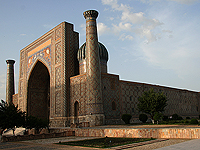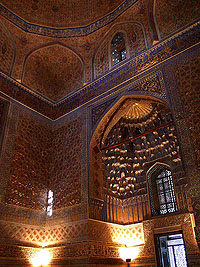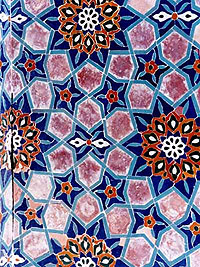 |
|
Uzbekistan - Samarkand Province |
|||||
|
Established: 1938 The Samarkand province is located in the central part of Uzbekistan , in the Zarafshon River Basin , between the Turkestan and Zarafshon Mountain Ranges. The province consists of 14 rural districts - Okdaryo, Bulunghur, Jomboy, Ishtikhon, Kattakurgbon, Koshrabot, Narpay, Nurobod, Payarik, Pastdarghom, Pakbtacbi, Samarkand, Toilok, Urgut; 11 towns - Oklosh, Bulunghur, Jomboy, Juma, Ishtikhon, Kattakurghon, Nurobod, Payarik, Samarkand, Urgut, Chelak; as well as 12 town- type-settlements and 125 villages. City of Samarkand is the administrative center of the province (354 km away from Tashkent, 364,3 thousand people). The northern part of the province consists of the Nurota Mountain Ranges, while the south is surrounded by the hills of the Zarafshon Mountain Ranges. The Zarafshon River Valley is located in the central part of the province. The province has rich deposits of marble (Gozghon, Omonkuton, and Moybulok), limestone, as well as granite. The climate of the province is continental and dry. The winter is mild and moderately cold, whereas the summer is hot and dry.
The economy of the province is based on well-established agriculture and industry. Heavy industry, mining, machinery, metal reprocessing, chemical and construction are the major production activities. Light industry is represented by cotton cleaning, sewing, textile and footwear enterprises. For many centuries Samarkand has been famous for its silk products. The silk processing and sewing factories are provided with local raw materials. The city is also famous for its grape products, as well. Major machinery enterprises in Samarkand and Kattakurghon produce refrigerators, spare parts for tractors, elevators, and more. There is also a ceramic production enterprise in Samarkand. More than 60 joint ventures, about 2000 small businesses and 100 cooperative enterprises are operating in the province; "Shark Lift", "Somrad", "Tulduz", "Armaya", "Jahon Trade", "Garzay Mekhnat Samarkand" to mention a few. Cotton and grape cultivation is well developed. The cotton is mainly cultivated in the Zarafshon River Valley. The Urgut province specializes in high quality tobacco cultivation. The province is famous for its gardens and grapes - the best in Uzbekistan. The province produces 100 percent of the country's total kyshmysh (a kind of grape) production. The livestock farming is well developed in northern and southern foothills of the mountain ranges. Province has the best quality livestock, most particularly karakul sheep breeding. To improve the quality of the product the Scientific Research Institute of Karakul Sheep Breeding was established. The bee-keeping and cocoon production is also on the rise. Collective farms, cooperative farms, and 7812 farming enterprises are operating in the province. The province has a well-developed transportation network of highways and railroads, water and gas pipelines, as well as electricity lines. Almost all the major cities have access to the railroad network. The city of Samarkand is a major point on this railroad network. The total length of the railroad network is 277 km. The length of automobile roads is 8,000 km. Samarkand is linked via air routes with a number of major cities throughout the nation. More than 1000 schools, gymnasiums, lyceums, musical and sporting schools, a university, four institutes and a number of colleges operate in the province. There are 4 theaters, 8 museums, and more than 800 libraries. Samarkand is the second largest city in Uzbekistan after Tashkent in size, industrial importance and population. It is a favorite tourist destination, located on the left bank of the Zarafshon River. The city is almost on the geometrical center of the country, on the crossroads of its automobile and airline routes, a very important factor for development. From 1924 to 1930 Samarkand was a capital of Uzbekistan. It is one of the oldest cities in the world and its historic architecture and monuments are as magnificent as the Egyptian pyramids. In the middle of the first millennium B.C. the city was called Marakanda , and later was renamed as Afrosiyob. Alexander the Great, Arabs and Genghis Khan all occupied this city at some stage in the past. It was the capital of the powerful Sogd Empire, and later became the capital of Amir Temur's massive empire. Temur focused on the fortification and decoration of the city. Under Temur and his descendants the city prospered. Famous architectural ensembles of the city are the Registan Square, which consists of three madrasah: Ulugbek, Sherdor and Tillakori; the Shokhi Zinda tombstone, which consists of 11 mausoleums; the marvelous Bibi-Khonim Mosque. The most famous building in the city is the Guri Amir , the tombstone of the great Amir Temur and his descendants. It is one of the best examples of eastern architecture of Middle Ages. The dark green and blue dome of the tombstone is magnificent. The famous Ulugbek observatory is located in the northeastern part of the city. Great statesman and scientist, Mirzo Ulugbek, built it in 1428-29. The lifeless hills not far from this place are the ruins of the great city of Afrosiyob, an ancient architectural city built before Arab conquest. The architectural monuments of the city attract tourists from all around the world. History, however, is not the only attraction of Samarkand. Today it is a major industrial and cultural center in Uzbekistan. Modern Samarkand is well planned with many tail, modern and uniquely designed buildings, green parks and squares. Ballet and opera theaters and concert halls operate in the city. Uzbekistan 's oldest museum of art and culture is located in Samarkand. Samarkand is also a major university town. There is a university as well as medical, agricultural, cooperative, architectural and construction institutes. The Institute of Archeology of the Science Academy of the Republic is also located in the city. The city industry is represented by machinery and lift construction, textile, sewing, shoe and furniture industries. The outskirts of Samarkand, especially Okhaklik and Omonkuton, have a beautiful nature. Kattakurgon is the second largest city of the Samarkand province. Machinery, food and oil production is well developed in the city. Samarkand Internet Reseources Samarkand Hotels - Photos and information about hotels in Tashkent |



